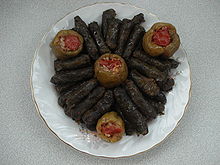Dolma
Dolma (taken from osm .: طولمه dolma / turk .: dolma ) is a specialty of oriental cuisine and refers to vegetables or grape leaves stuffed with rice or minced meat .
“Dolma” is the Turkish word for “filled” and is used for a variety of dishes with filled vegetables, such as the traditional summer mix of tomatoes, eggplants and peppers that are either baked or boiled.
Dolma filled with rice are traditionally eaten cold, filled with meat warm.
For preparation, the stalks are cut off from fresh vine leaves, the leaves are blanched for a few minutes in boiling salted water and then placed on a sieve to drain. Some filling is placed on each vine leaf and rolled up. The stuffed vine leaf is boiled or braised in broth or wine and drizzled with olive oil and lemon juice.
variants
- Aramaic / Assyrian dolma (Aramaic: aprache ) is filled with rice, fine pieces of veal and vegetables and is mostly eaten warm.
- Turkish and Arabic Dolma is filled either with rice, meat and vegetables (e.g. peppers and tomatoes, warm) or just with rice and vegetables, coriander, pine nuts, and raisins from Corinth (as a cold dish).
- Armenian dolma are filled with rice, minced meat, lots of tarragon, and coriander, and are usually served with yogurt (and chopped garlic). Also stuffed aubergines, tomatoes, peppers or minced meat wrapped in cabbage leaves with rice, coriander, parsley and blue basil, cooked in tomato sauce with quince.
- Albanian sarma are grape leaves stuffed with fried ground beef and risotto rice , eaten with bread and tarator .
- Azerbaijani dolma is a warm dish and is traditionally filled or wrapped with minced lamb and spices.
- Greek dolmades do not contain meat, but a rice filling that is provided with many herbs (especially dill).
- Georgian dolma is cooked and served just like Armenian dolma.
- Chechen dolma is filled with rice, meat, vegetables, and herbs.
- In Bosnian , Croatian and Serbian cuisine, sour white cabbage leaves are usually used instead of grape leaves for the preparation of sarma . Stuffed vine leaves are also quite common in Bosnia. They are then called Japrak. Both variants are filled with minced meat (usually a mixture of pork and beef), rice and herbs. Sarma is served on public holidays in many countries of the former Yugoslavia (e.g. Christmas).
- Kurdish dolma ( Kurdish : yaprakh ) is a warm dish and is traditionally filled or wrapped with rice, minced meat, herbs and spices.
- The Bulgarian sarma (Bulgarian сърма ; spoken sɤr'mɐ ) are prepared with short grain rice, mixed minced meat, onions and herbs and wrapped either with vine leaves or with sauerkraut leaves. They are served warm (not eaten cold). Filling with rice alone is also not uncommon in Bulgaria. The vine leaf rolls are served with a spoon of yogurt. Both types are a main course.
Web links
Individual evidence
- ↑ dolma. Oxford University Press , accessed July 25, 2020 .
- ^ Richard Hosking : Food and Language: Proceedings of the Oxford Symposium on Food and Cooking 2009 . Oxford Symposium, 2010, ISBN 978-1-903018-79-8 , pp. 202 ( google.de [accessed on July 24, 2020]).



